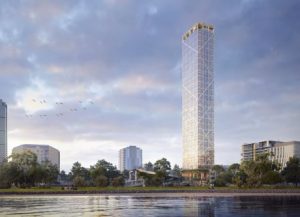
A $350m development, set to become the world’s tallest timber tower, has been approved after the WA planning authority overruled a recommendation by the City of South Perth. Source: Jason Ross, Wood Central
The panel claims that the mass timber project meets “design excellence” and “global sustainability standards.”
The project dominated discussions at a WA Government Development Assessment Panel meeting yesterday.
Melbourne developer James Dibble told the panel that the development “will address the state’s critical housing shortage.”
Mr Dibble’s Grange Development is behind the development, known as C6, the world’s tallest hybrid timber, three metres higher than Atlassian’s new Sydney headquarters.
Wood Central can reveal that the panel unanimously approved the project with reports that two panel members connected to the city were not in attendance.
According to Business News, the panel discussion was dominated by heated debate over the project’s alignment with “design excellence standards.”
Addressing these concerns, Mr Dibble said the building, made up of 42% timber, “would set the benchmark for carbon-negative design.”
He told the panel that “just 600 seeds would be used to produce 7,400 cubic metres of mass timber, which would regrow after being used in the development.”
“You can’t regrow concrete,” he said, with the project team “providing an open source blueprint that utilises hybrid construction methodology to offset carbon within our built environment.”
Renders produced to support the DA show extensive use of green space in the lobby and on the rooftop. (Photo Credit: Supplied by Grange Developments)
Mr Dibble said that the building and construction industry is the world’s largest net emitter and that utilising low-embodied carbon building materials is critical in addressing climate change.
His claims are supported by a new UN report published earlier this month. The reports suggest substituting carbon-intensive building materials, like steel and concrete, for bio-based materials, including timber, bamboo, and biomass, will reduce emissions by up to 40% by 2050.
“Steel and concrete are some of the most energy-dense materials in the world to produce, and at the moment, the industry relies on it,” Mr Dibble said in an interview with the Urban Developer last year.
“If we can accelerate a paradigm shift into using more renewable building materials such as mass timber in a hybrid nature and see even 10, 15 or 20 per cent of future projects use mass timber in their construction in the next few years, we will have succeeded.”
As reported by Wood Central last week, the city refused the development because “the height was inconsistent with the planning framework.”
At 187 metres, Mr Dibble is seeking approval for a “Tier 2 building height” with no limit and instead is discretionary.
According to the DA, the proposed development comprises 237 dwellings, a ground floor cade, a rooftop space, communal facilities, a horticultural workshop and an urban farm.
The report tabled to the Metro Inner-South Joint Development Assessment Meeting stated that the “architectural design of the proposed development has not achieved design excellence and consequently, about the Tier 2 building height proposed, cannot be supported.”
The project has undergone several design iterations and was discussed in at least two design panel meetings before the meeting – in May 2023 and again in July 2023.
Addressing design concerns, Reade Dixon said the project is “establishing an approach to mass timber at a scale that has never been contemplated and provides a pathway for climate-positive architecture.”
Mr Dixon has been working with architects from Perth-based Cameron Chisolm Nicol on the development and also claimed that “slender towers provided reduced impacts of overshadowing and deeper penetration of sunlight.”







